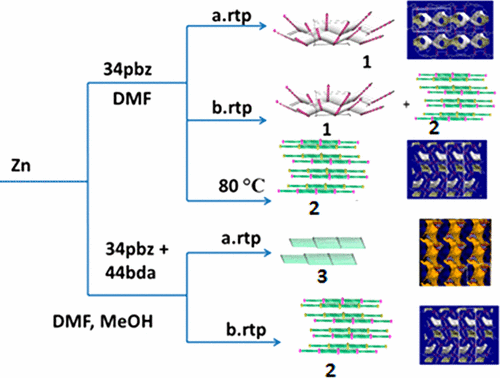当前位置:
X-MOL 学术
›
Cryst. Growth Des.
›
论文详情
Our official English website, www.x-mol.net, welcomes your
feedback! (Note: you will need to create a separate account there.)
Structural Diversity Observed in Two-dimensional Square Lattice Metal–Organic Frameworks Assembled from Zn(II) and 3-(4-Pyridyl)benzoate
Crystal Growth & Design ( IF 3.2 ) Pub Date : 2017-11-03 00:00:00 , DOI: 10.1021/acs.cgd.7b01101 Gift Mehlana 1, 2 , Chad Wilkinson 1 , Christelle N. Dzesse T. 1, 3 , Gaëlle Ramon 1 , Susan A. Bourne 1
Crystal Growth & Design ( IF 3.2 ) Pub Date : 2017-11-03 00:00:00 , DOI: 10.1021/acs.cgd.7b01101 Gift Mehlana 1, 2 , Chad Wilkinson 1 , Christelle N. Dzesse T. 1, 3 , Gaëlle Ramon 1 , Susan A. Bourne 1
Affiliation

|
The reaction of 3-(4-pyridyl)benzoate (34pbz) under solvothermal and solvent evaporation conditions produced several two-dimensional (2D) square lattice metal–organic frameworks compounds, {[Zn(34pbz)2]·DMF}n (1), {[Zn(34pbz)2]·DMF}n (2), and {[Zn(34pbz)2]·2DMF·CH3OH·1/2H2O}n (3). Although the frameworks of 1, 2, and 3 have identical elemental composition, these networks differ in the binding mode of the carboxylate moiety to the metal center. In compound 1 the carboxylate moiety assumes a monodentate binding mode, while in 2 and 3 it assumes a chelating binding mode. Compounds 1 and 3 crystallize in space group P21/c with different unit cell parameters, while compound 2 crystallizes in the tetragonal crystal system. In all three crystal structures, networks are formed by connecting mononuclear Zn(II) units with 34pbz linkers forming a square grid network. The solvent accessible void volumes in 1 (21%) and 2 (18%) are comparable, while compound 3 has a void volume of 42%, which is extremely large for a 2D network. Crystals of 2 were activated by heat treatment to give [Zn(34pbz)2]n (2d), which has narrow pores. When exposed to the vapors of xylene isomers, the narrow pores in 2d expanded to accommodate the incoming guest molecules between the 2D layers. Thermogravimetric analysis established that when 2d is exposed to the isomers of xylene, the amount of the xylene adsorbed increases in the order meta- < para- < ortho-xylene, due to the different packing efficiency of the guest molecules in the cavities. Compound 2d shows no discrimination for one species from an equimolar mixture of all three xylenes.
中文翻译:

在由锌(II)和3-(4-吡啶基)苯甲酸酯组装而成的二维方格金属有机框架中观察到的结构多样性
溶剂热和溶剂蒸发条件下3-(4-吡啶基)苯甲酸酯(34pbz)的反应产生了几种二维(2D)方格金属-有机骨架化合物,{[Zn(34pbz)2 ]·DMF} n(1),{[Zn(34pbz)2 ]·DMF} n(2)和{[Zn(34pbz)2 ]·2DMF·CH 3 OH·1 / 2H 2 O} n(3)。虽然框架1,2,和3具有相同的元素组成,这些网络中的羧酸盐部分与金属中心的结合模式而不同。在化合物1中羧酸盐部分假定为单齿结合模式,而在2和3中则假定为螯合结合模式。化合物1和3在具有不同晶胞参数的空间群P 2 1 / c中结晶,而化合物2在四方晶体系统中结晶。在所有这三种晶体结构中,网络都是通过将单核Zn(II)单元与形成方形网格网络的34pbz接头连接而形成的。1(21%)和2(18%)的溶剂可及空隙体积可比,而化合物3具有42%的空隙体积,对于2D网络而言,这是非常大的。2的晶体通过热处理活化,得到具有狭窄孔的[Zn(34pbz)2 ] n(2d)。当暴露于二甲苯异构体的蒸气中时,2d中的细孔会膨胀,以容纳2D层之间的传入客体分子。热重分析确定,当2d暴露于二甲苯的异构体时,由于腔中客体分子的不同填充效率,二甲苯的吸附量按间位-<对位-<邻二甲苯的顺序增加。化合物2d 不能从所有三种二甲苯的等摩尔混合物中分辨出一种。
更新日期:2017-11-03
中文翻译:

在由锌(II)和3-(4-吡啶基)苯甲酸酯组装而成的二维方格金属有机框架中观察到的结构多样性
溶剂热和溶剂蒸发条件下3-(4-吡啶基)苯甲酸酯(34pbz)的反应产生了几种二维(2D)方格金属-有机骨架化合物,{[Zn(34pbz)2 ]·DMF} n(1),{[Zn(34pbz)2 ]·DMF} n(2)和{[Zn(34pbz)2 ]·2DMF·CH 3 OH·1 / 2H 2 O} n(3)。虽然框架1,2,和3具有相同的元素组成,这些网络中的羧酸盐部分与金属中心的结合模式而不同。在化合物1中羧酸盐部分假定为单齿结合模式,而在2和3中则假定为螯合结合模式。化合物1和3在具有不同晶胞参数的空间群P 2 1 / c中结晶,而化合物2在四方晶体系统中结晶。在所有这三种晶体结构中,网络都是通过将单核Zn(II)单元与形成方形网格网络的34pbz接头连接而形成的。1(21%)和2(18%)的溶剂可及空隙体积可比,而化合物3具有42%的空隙体积,对于2D网络而言,这是非常大的。2的晶体通过热处理活化,得到具有狭窄孔的[Zn(34pbz)2 ] n(2d)。当暴露于二甲苯异构体的蒸气中时,2d中的细孔会膨胀,以容纳2D层之间的传入客体分子。热重分析确定,当2d暴露于二甲苯的异构体时,由于腔中客体分子的不同填充效率,二甲苯的吸附量按间位-<对位-<邻二甲苯的顺序增加。化合物2d 不能从所有三种二甲苯的等摩尔混合物中分辨出一种。









































 京公网安备 11010802027423号
京公网安备 11010802027423号